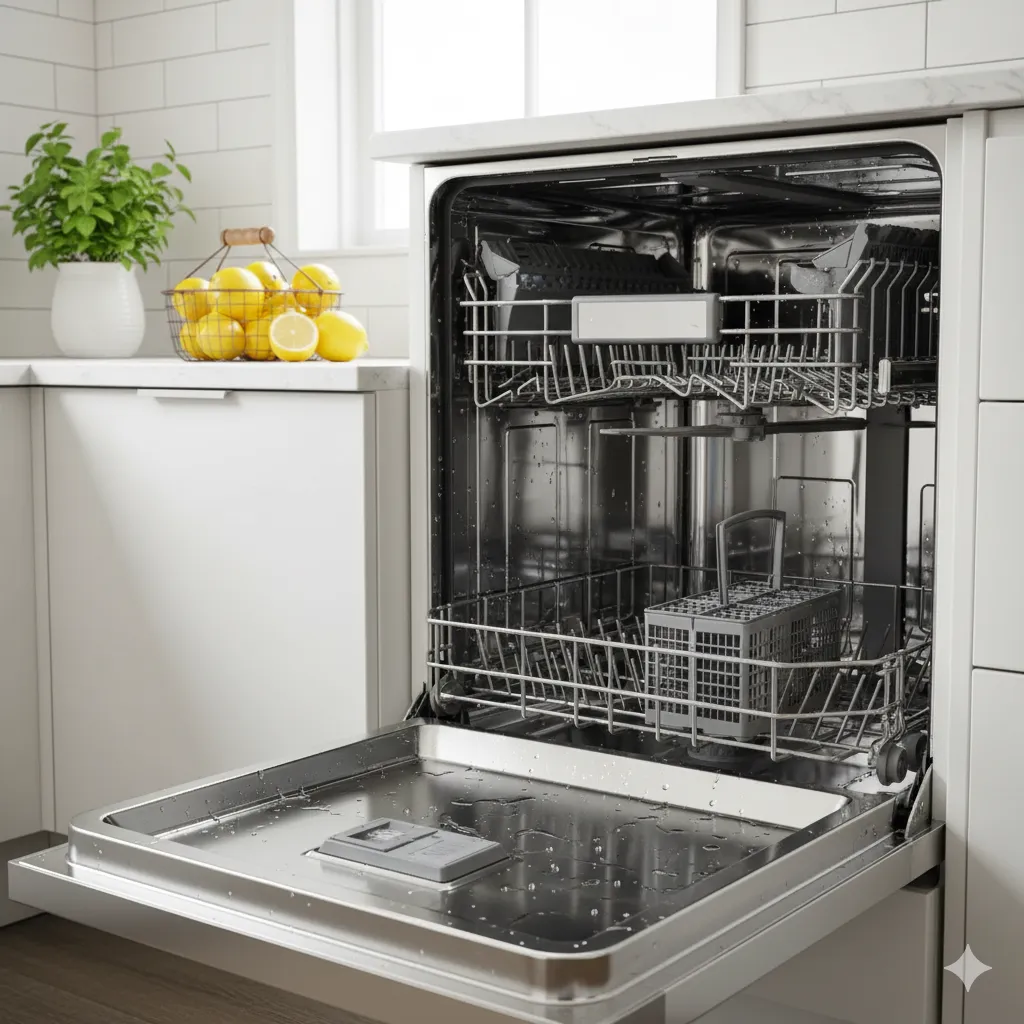I’m going to be straight with you: for years, I completely bought into the lie that the machine designed to clean dirty dishes somehow magically cleans itself. Right? It runs a cycle, hot water blasts everywhere, and poof—it’s clean. Sounds logical, but if you’ve ever opened your machine after a supposedly “clean” cycle and been hit with that stale, funky smell, you know the truth: you’ve been duped. Your dishwasher, bless its heart, gets incredibly gross.
It’s an eternal cycle of grime. Tiny food scraps, grease, soap scum, and those pesky hard water minerals all build up until your machine is essentially washing dishes with dirty water. Ew. This isn’t just about a stinky kitchen; a truly clean dishwasher is a game-changer. It means you’ll get genuinely sparkling glassware, no more mysterious residue on your plates, better hygiene, and, honestly, a much longer life for your expensive appliance.
In this post, you’ll learn exactly how to clean dishwasher using simple, natural methods—primarily with household heroes like vinegar and baking soda. This isn’t just a quick surface wipe; we’re talking about a full-on deep clean dishwasher mission. We’ll go step-by-step through the nooks and crannies, and I promise, you’ll want to snap a Pinterest-worthy before & after shot of your dazzlingly clean machine. Ready to stop washing dishes with yesterday’s leftover lasagna grime? Let’s do this.
Why & When to Schedule Your Dishwasher Maintenance
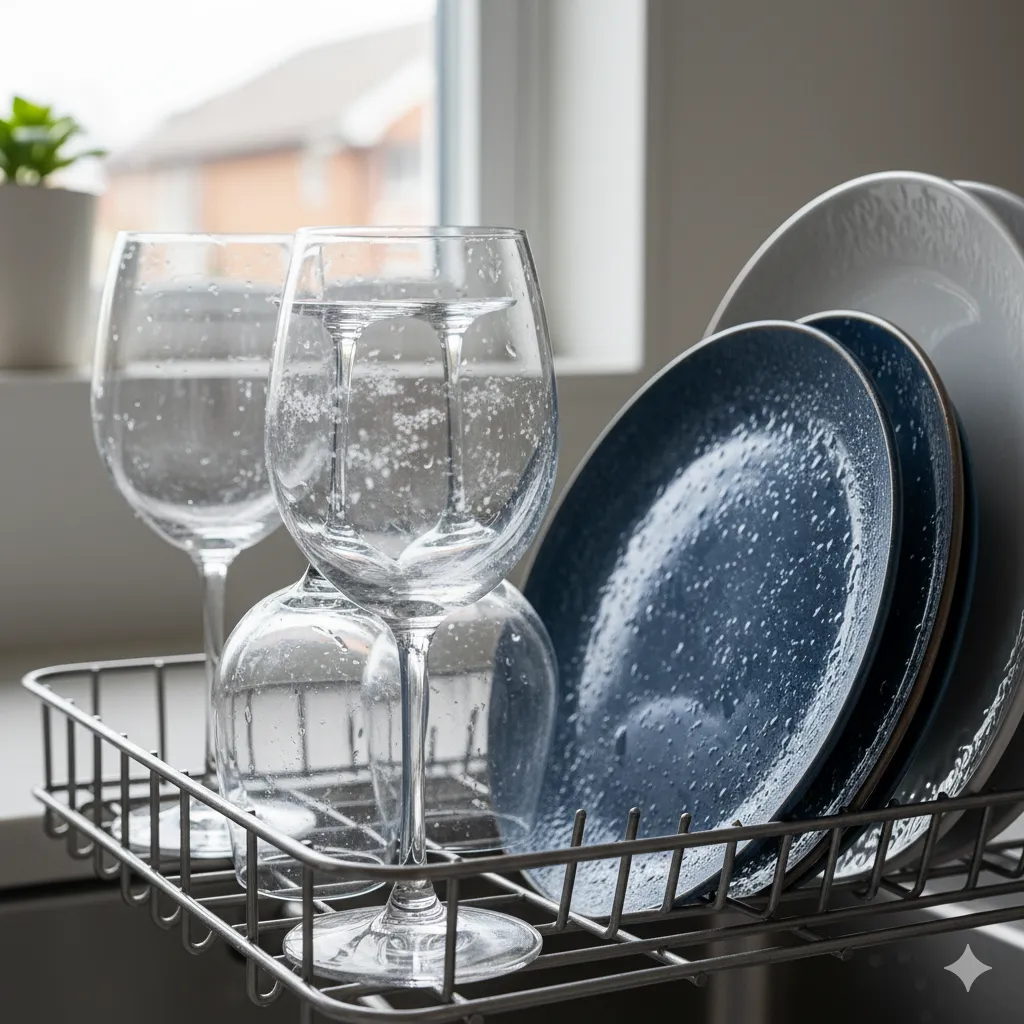
Think of your dishwasher as the unsung hero of your kitchen—it works hard, hidden away, but it requires some serious TLC, too. Skipping dishwasher maintenance is a recipe for disaster, or at least a recipe for some truly unpleasant issues.
Common Problems from a Dirty Dishwasher
Dirty dishwashers don’t just smell bad; they actively sabotage their own performance. You’re trying to clean, but they’re just spreading the mess around.
- The Funk: Unpleasant odors are the most obvious sign. That sour, stale smell usually comes from trapped food particles rotting in the filter or spray arms.
- Residue Everywhere: If your glassware has cloudy spots or your plates have a gritty film, it’s likely detergent build-up and mineral deposits being redeposited on your dishes.
- Clogs and Slow Draining: A clogged filter or blocked spray arm nozzles means your machine isn’t running efficiently, which can lead to standing water and poor cleaning performance.
- Reduced Efficiency: When the machine is gunked up, it has to work harder to heat the water and pump it, which can impact your utility bills.
Signs It’s Time to Clean
Your dishwasher will send you distress signals when it’s time for a scrub-down. Don’t ignore them!
- The Sniff Test: A smell coming from the machine, even when it’s empty, is your biggest clue. You need that dishwasher odor fix, ASAP.
- Spotted Glassware: If you’ve switched detergents and still get spots on your wine glasses, you have mineral or detergent buildup in the machine itself.
- The Water Tactic: If you see water pooling in the bottom after a cycle, you likely have a clogged filter or a draining issue that needs immediate attention.
Recommended Frequency for a Clean Machine
So, how often to clean dishwasher? I like to work on a tiered schedule.
- Monthly Quick Clean: Run a vinegar cycle (more on this in a bit!) and wipe down the gaskets. This is your monthly check-in to keep things fresh.
- Quarterly Deep Clean: Every three months, it’s time for a full-on deep clean dishwasher session. This includes pulling out the filter and spray arms.
- Spot Checks: After any cycle where you ran something particularly greasy or messy (like a turkey pan or lots of cheesy casserole dishes), give the filter a quick check just to be sure.
Hack #1: The Quick Smell Fix
If you have people coming over in 10 minutes and your machine smells like gym socks, toss a lemon or orange peel into the detergent dispenser and run a quick rinse cycle. The citrus oil will momentarily mask the worst of the smell until you can do a proper clean.
Supplies You’ll Need for Your Deep Clean
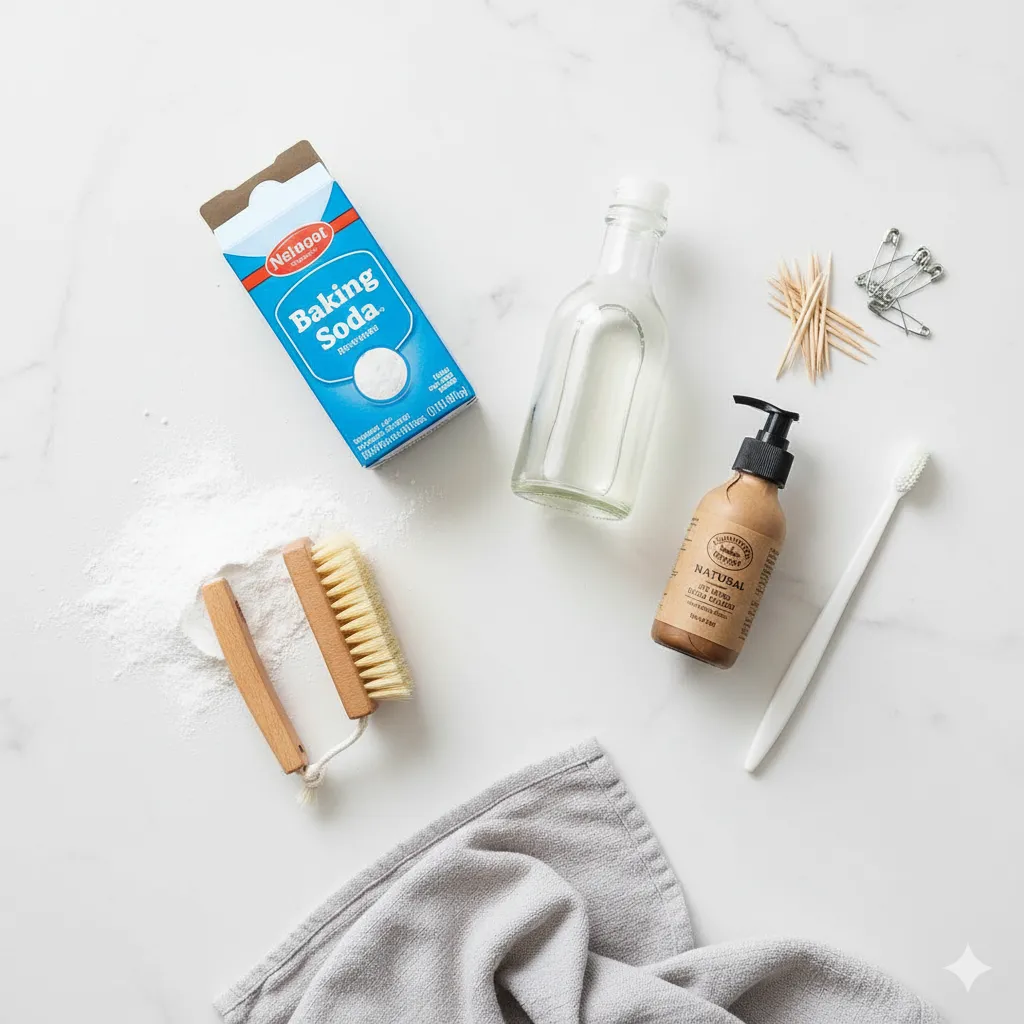
Before you start dismantling your appliance, you need to gather your cleaning arsenal. The best part about this whole process? Everything you need is probably already in your pantry. We’re keeping things simple and natural!
The Essentials List
These are the non-negotiables for a great, chemical-free clean:
- White Vinegar: The absolute king of natural dishwasher cleaner. It’s acidic, which makes it perfect for breaking down grease, soap scum, and those pesky mineral deposits.
- Baking Soda: The ultimate deodorizer. It gently scrubs and absorbs odors like a champ.
- Liquid Dish Soap: Just a drop or two for scrubbing the removable parts.
- Soft Brush or Old Toothbrush: You need something small to get into those tight spaces and scrub the filter mesh.
- Toothpick or Safety Pin: Essential for unclogging spray arm nozzles.
- Microfibre Cloth: For wiping down the interior and exterior of the door.
Optional, But Helpful
If you have super hard water, you might want to consider these additions:
- Citric Acid Powder: A more potent descaling agent than vinegar, fantastic for tackling really stubborn hard water buildup.
- Commercial Dishwasher Cleaner Tablets: Keep a box on hand for those times when you just don’t have the energy for a manual clean.
A Word of Caution, Friends!
I’ve seen some truly terrible advice out there, so let me give you a quick tip: avoid harsh chemicals. Specifically, do not use bleach in your dishwasher, especially if you plan to use vinegar. Mixing them creates toxic chlorine gas—definitely not an ingredient for a clean kitchen! Also, be gentle with those rubber gaskets; harsh abrasives can damage them and cause leaks.
Hack #2: The Gasket Glow-Up
For cleaning those tough-to-reach rubber door gaskets, wrap a microfibre cloth around a butter knife and dip it into a bit of vinegar. It creates a perfect, stiff-yet-flexible cleaning tool to get into the groove where all the mold and grime like to hide.
Step-by-Step Guide: How to Clean a Dishwasher
Okay, now for the main event! This is where we stop talking about a clean machine and actually get a clean machine. Follow these steps for the ultimate deep clean dishwasher.
Step 1: Remove & Clean the Dishwasher Filter
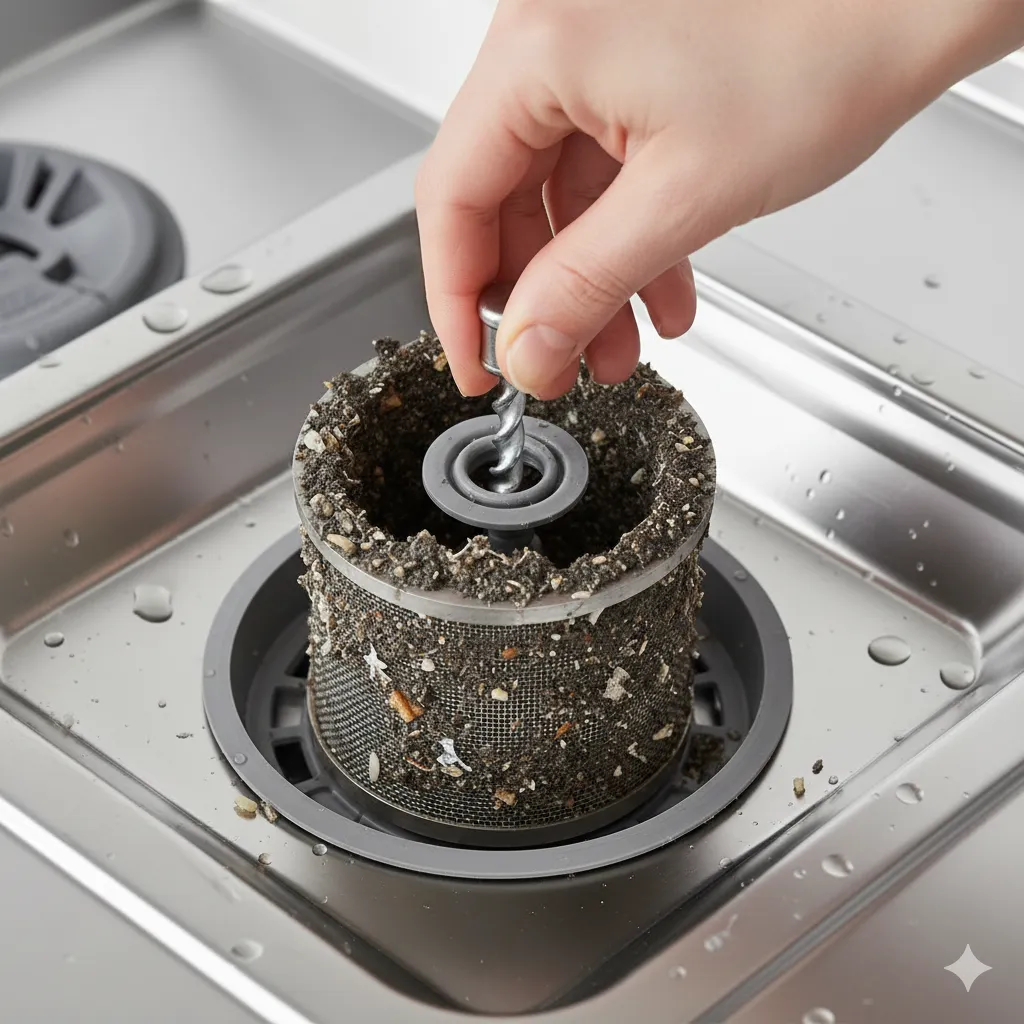
This is arguably the most critical step and one most people skip. If you still wonder why your dishes aren’t spotless, chances are your filter is disgusting.
- Locate and Remove: Look at the very bottom of your dishwasher tub. You’ll usually see a cylindrical filter and/or a flat mesh screen. Most simply unscrew or unclip with a quarter turn. Refer to your manual if you’re unsure, but IMO, it’s usually pretty intuitive.
- Scrub the Gunk: Take the filter to your sink. You will be horrified by what you find—it’s usually a sludgy mixture of old food particles, rice, labels, and general slime. Use warm water, a tiny drop of dish soap, and your soft brush or old toothbrush to scrub every crevice and the fine mesh screen.
- Rinse and Replace: Rinse it thoroughly until the water runs clear. This step is a total game-changer, and congratulations, you’ve completed the toughest part of clean dishwasher filter! Put it back, ensuring it clicks or locks securely.
Step 2: Clean Spray Arms & Nozzles
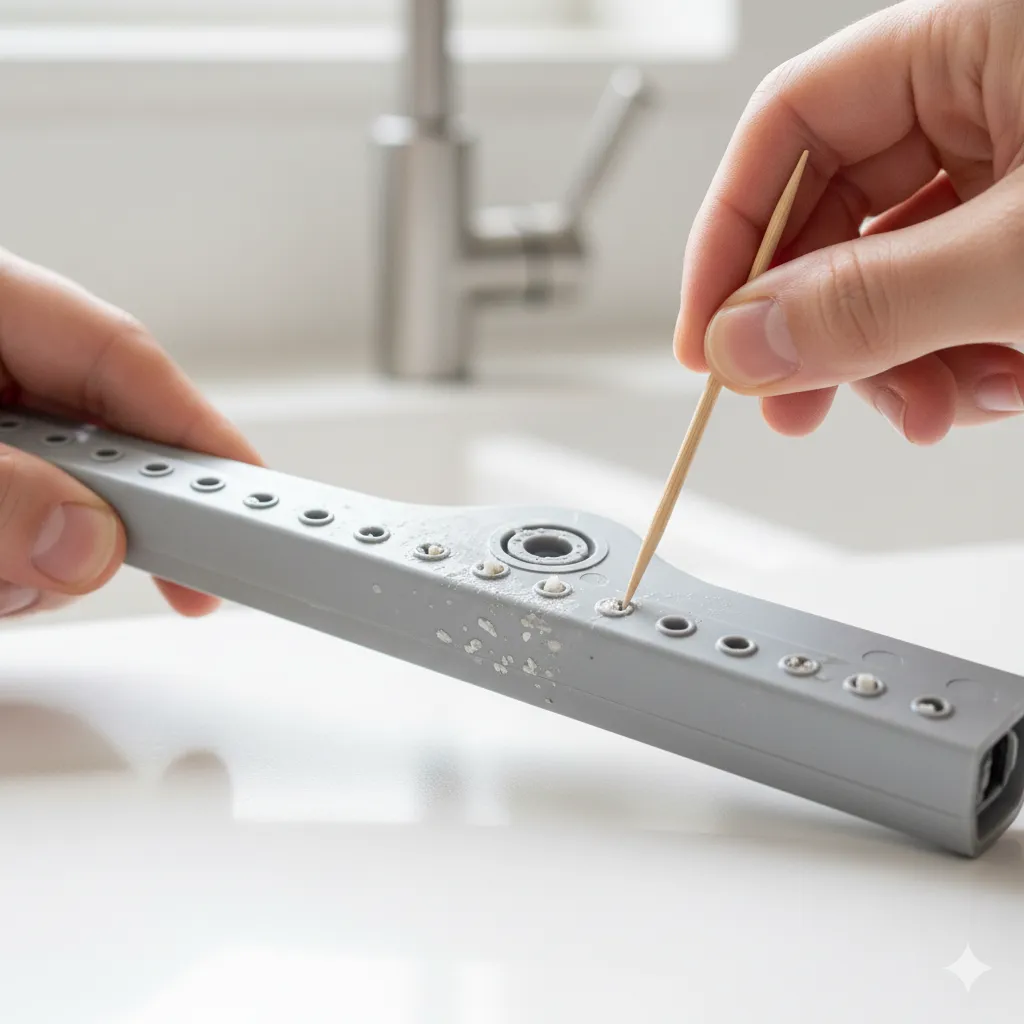
Those spinning arms are how the water gets everywhere, so if their tiny holes are blocked, the water jets are weak, and your dishes won’t get clean. We need to clean spray arms dishwasher style!
- Detach (If Possible): Many spray arms (especially the lower one) simply unscrew. If your model allows, take them out for easier access.
- Unclog the Holes: This is where your toothpick or safety pin comes in handy. Carefully poke into every single little nozzle hole to push out any trapped mineral buildup or food bits. Be gentle—we don’t want to make the holes bigger, just clear them out.
- Rinse: Give the spray arms a good rinse under the faucet before you reattach them.
Step 3: Wipe Down Interior Surfaces & Door Gaskets
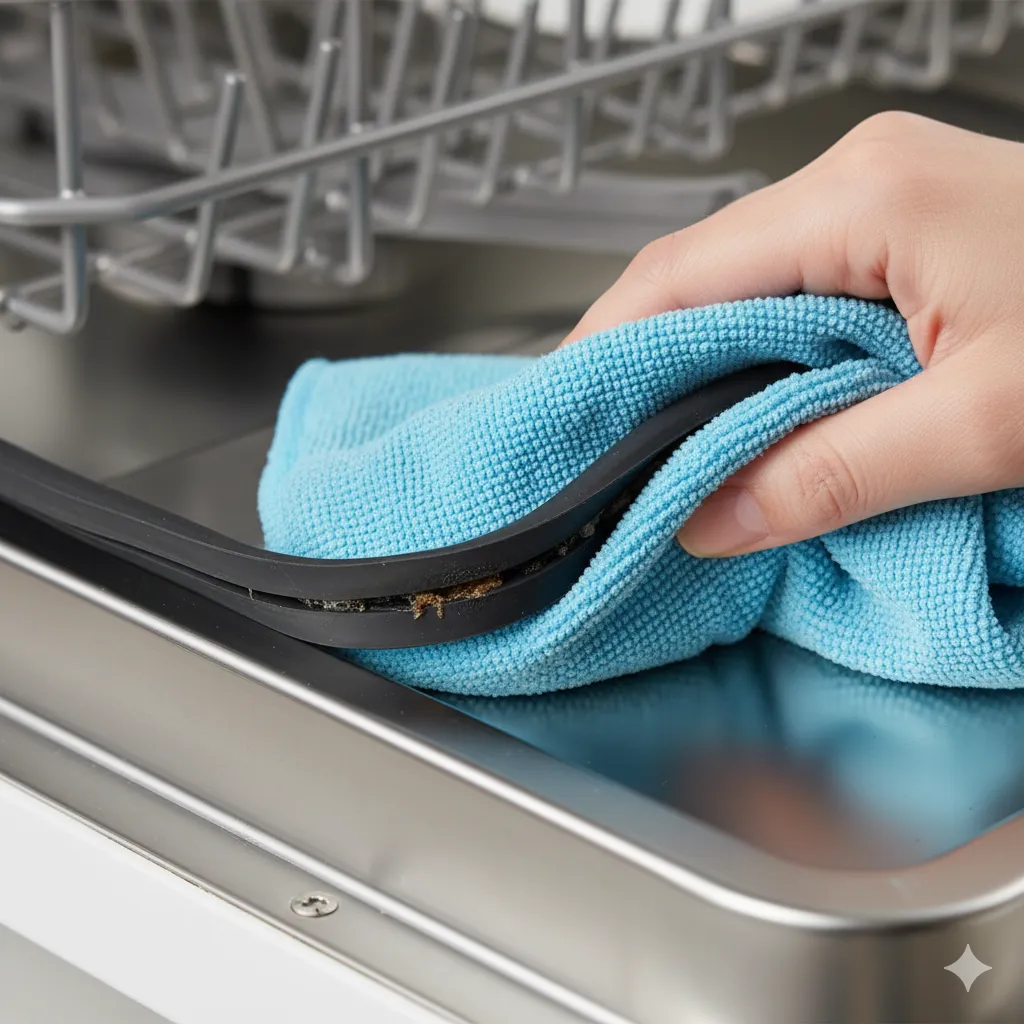
While the machine is empty, you’ll want to get the door and the interior walls.
- The Gasket Groove: Pay special attention to the rubber gaskets around the door. Slime and mold love this area. Use your cloth and a little vinegar to wipe deeply into the grooves. This is also a good time to check around the buttons or latch.
- The Walls: Quickly wipe down the bottom lip of the door and the walls where water sometimes splashes but doesn’t fully rinse away.
Step 4: Run a Vinegar Cycle: The Descaling Powerhouse
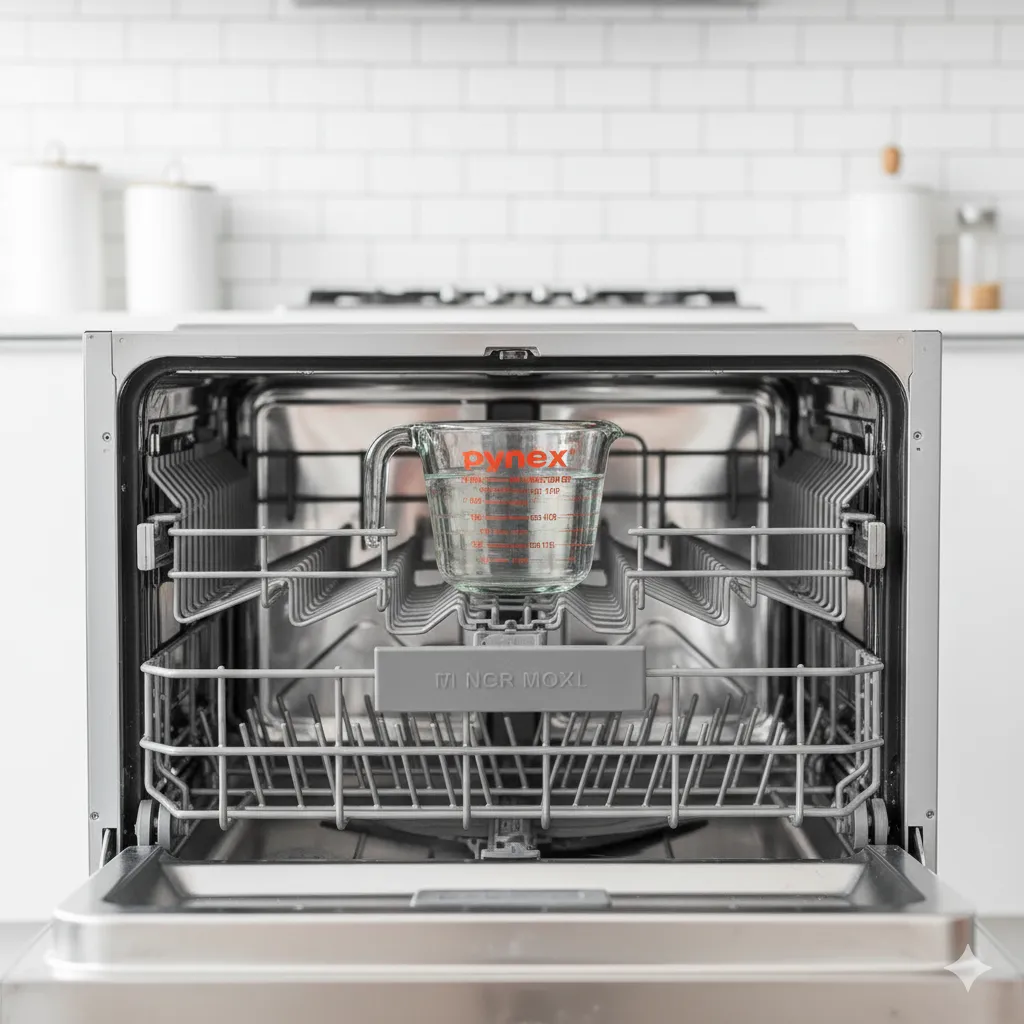
This is the famous how to clean a dishwasher with vinegar step. It’s fantastic for tackling scale, grease, and those awful mineral deposits that are a fact of life with hard water.
- Prep the Vinegar: Pour one cup of white cleaning vinegar into a dishwasher-safe cup or bowl. I just use a Pyrex measuring cup.
- Place and Run: Place the cup upright on the top rack.
- Cycle Time: Run the machine on its hottest, longest cycle (completely empty). The hot water activates the vinegar steam, which descales the entire interior—the pump, the heating element, the racks—everything! It degreases, sanitizes, and breaks down hard water spots like a champ.
Step 5: Baking Soda Rinse: The Deodorizing Finisher
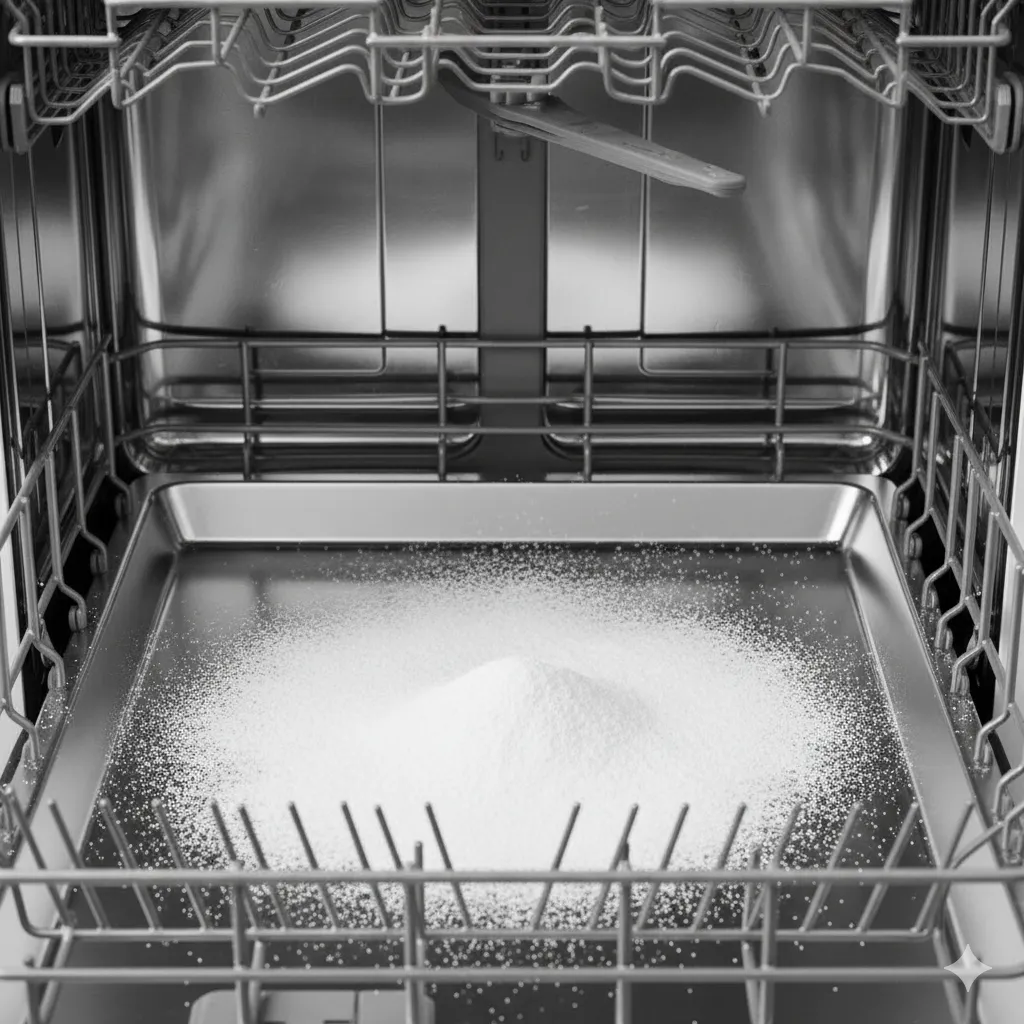
The vinegar cycle does the heavy lifting, but the baking soda is like a final flourish, the perfect deodorizer.
- Add the Soda: Sprinkle about a half a cup of baking soda across the bottom of the empty dishwasher tub.
- Short and Hot: Run a short, hot rinse cycle. The baking soda will absorb any remaining odors, gently scrub away stains, and neutralize any lingering vinegar smell.
Step 6: (Optional) Use a Commercial Dishwasher Cleaner
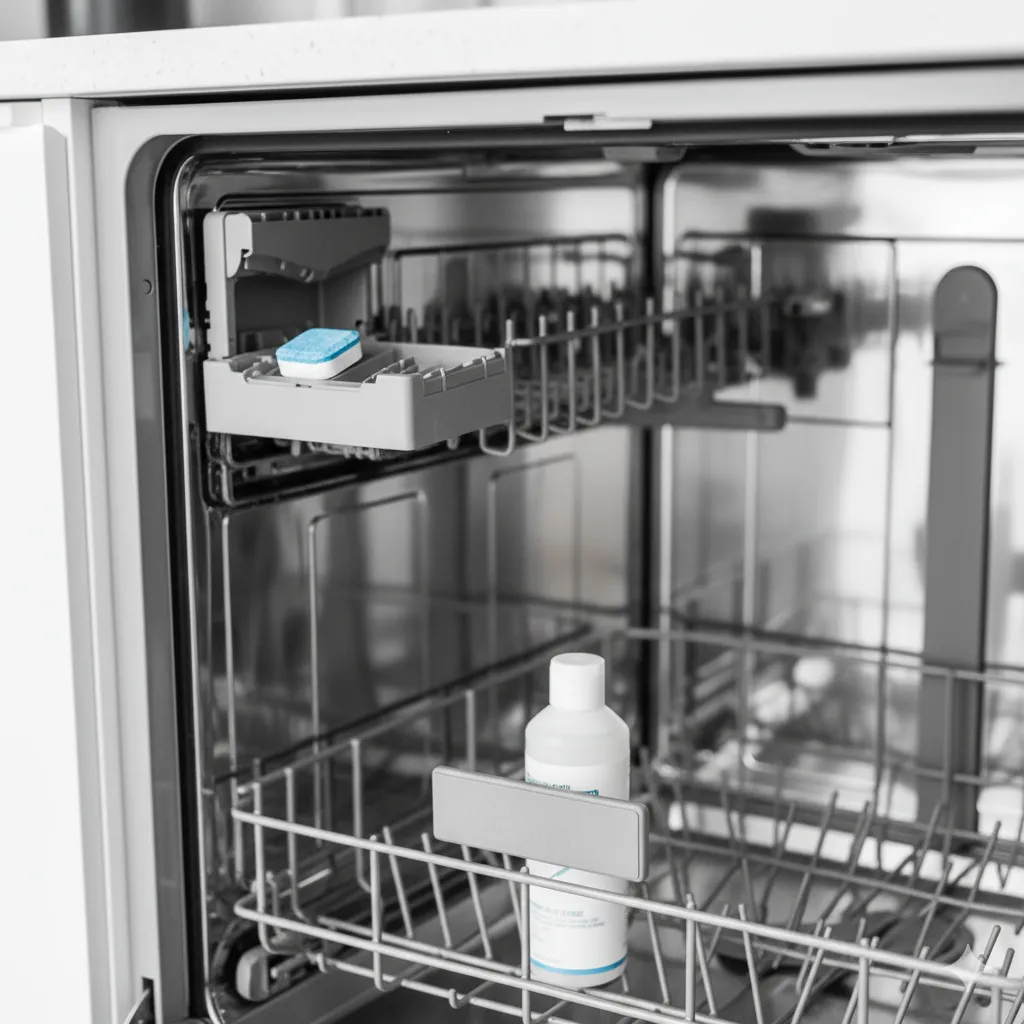
If your machine has seriously heavy, years-long buildup—or if you simply prefer the convenience—a dedicated cleaner tablet is a solid option.
- When to Use It: I recommend this for machines that haven’t been cleaned in years or for areas with extreme hard water.
- Instructions: Follow the package directions, which usually involve placing the tablet in the detergent dispenser or on the bottom rack and running an empty, hot cycle.
Hack #3: The Toothbrush and Thread Trick
For really stubborn gunk inside the spray arm holes, after you’ve used a toothpick, try running a piece of dental floss through the hole like a tiny piece of string, saw it back and forth, and pull it out. It’s surprisingly effective at grabbing unseen sludge!
Troubleshooting & Dishwasher Cleaning Tips
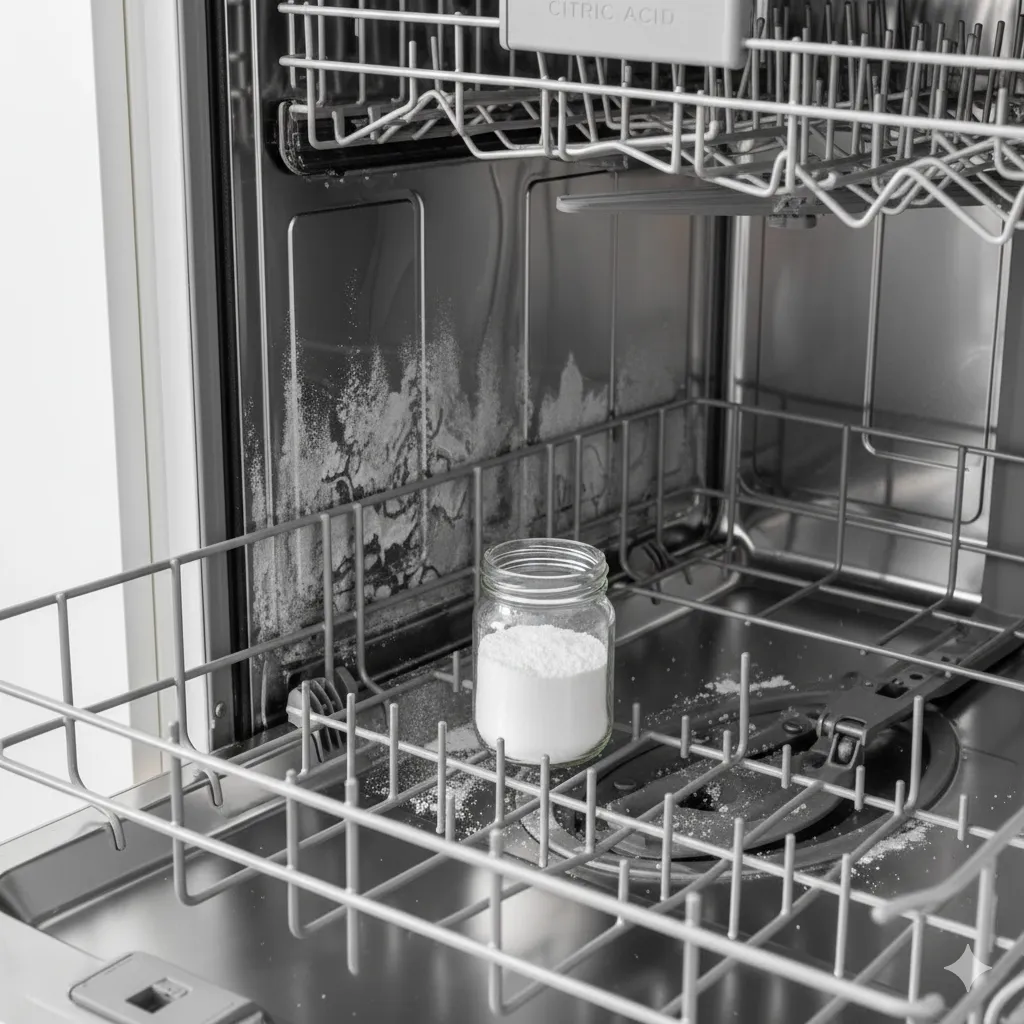
Even after a deep clean, sometimes little issues crop up. Here are quick fixes for common post-cleaning woes.
What to do if there’s still odor or slime
If the funk persists after your vinegar and baking soda wash, the problem is deeper:
- Check the Drain Hose: Sometimes gunk gets stuck in the drain hose leading to your sink’s garbage disposal or drainpipe. Run your garbage disposal for a minute to clear anything in the connecting pipe.
- Check the Trap: Some models have a small, easily missed “trap” or collection area where debris settles. Consult your manual to see if your model has one and how to check it.
For Hard Water / Mineral Buildup
If you’re battling white, chalky residue, you need a stronger acid:
- Citric Acid Boost: Instead of vinegar, use 1/4 cup of citric acid powder. Place it in the detergent dispenser and run a long, hot cycle. It’s a heavy-duty descaler and will make your stainless steel shine.
Avoiding Damage (and The Bleach Ban!)
- Stainless Steel Surfaces: Never, ever use bleach or any abrasive cleaner on a stainless steel interior. It can permanently pit and discolor the metal.
- Abrasives: Be gentle with scrubbing pads; stick to soft brushes and cloths to protect the plastic and rubber components.
Hack #4: The Lemon Rind Shine
Want a beautiful, chemical-free scent and a little extra polish? Throw a few used lemon rinds into the silverware holder and run a quick rinse cycle. The heat releases the lemon oil, giving your entire kitchen a fresh, clean scent. Plus, it acts as a mild brightener.
Ongoing Maintenance: The Key to Forever-Clean Dishes
The key to preventing another disgusting scenario is consistent dishwasher maintenance. A little effort now saves you a massive cleaning job later.
Quick Weekly / Monthly Routines
- The Weekly Gasket Wipe: Every time you unload the dishwasher, take two seconds to wipe down the rubber gasket with a damp cloth. This prevents mold and mildew from taking hold.
- Monthly Vinegar Run: Keep up that monthly empty vinegar cycle to keep the scale and soap scum under control.
- Filter Check: Every week or two, give the filter a quick glance. If you see chunks, pull it out for a quick rinse.
What to Avoid Putting in the Dishwasher
Prevention is the best medicine! A lot of clogs start with things we shouldn’t put in the machine:
- Labels and Adhesives: They peel off and end up clogging the filter.
- Large Bones or Pits: Always scrape these out before loading.
- Toothpicks and Skewers: They are perfect for getting stuck in spray arm nozzles or the filter.
Best Practices for Loading
Loading correctly can actually help keep your machine cleaner.
- Face the Jets: Make sure the dirtiest surfaces face the center spray arm.
- No Blocking: Avoid blocking the detergent dispenser door or, more crucially, the rotating spray arms with large items (such as cookie sheets or large bowls). If the arms can’t spin freely, the whole machine is useless.
Hack #5: The Filter Basket Pre-Rinse
When you pull out your filter for a cleaning, use a small glass or jar brush (like a baby bottle brush) to clean the inside of the hole where the filter sits. It’s often coated in a slick, invisible film of grease and soap scum that a larger brush won’t reach.
Final Thoughts & Your Next Step
So, there you have it. The secret to sparkling dishes isn’t just a great detergent; it’s a great, clean machine. You now know exactly how to clean dishwasher from the filter to the spray arms, and you’re armed with the dishwasher maintenance knowledge to keep it that way.
We took the deep dive, tackled the grime with simple household ingredients, and banished that awful dishwasher funk forever. It’s a little work, sure, but it will save you so much hassle (and money on spot-removing rinse aids!) in the long run.
Why not try this deep clean dishwasher process this weekend? Block off an hour, put on some music, and tell me your results! Did you find something truly terrifying in your filter? I want the gory details! And don’t forget to pin this post so you have the ultimate dishwasher cleaning checklist ready for your next quarterly deep clean!
Printable Recipe Card
Want just the essential recipe details without scrolling through the article? Get our printable recipe card with just the ingredients and instructions.
